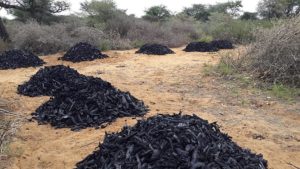
Rome, Italy// — “The idea of grass charcoal had never crossed my mind!” exclaims Mary Tiekor, Handi Women’s Group member and charcoal producer, as she holds a freshly made organic briquette in her hands. “And yet, here it is – and the process is so quick!”
Like Mary, over six million people in Ghana’s savannah ecological zone depend on wood fuel and tree charcoal for daily use, and this represents just a fraction of the more than 2.4 billion people worldwide that rely on firewood and charcoal for cooking, energy and income.
Unsustainable practices in charcoal production have led to deforestation and degradation of the country’s environment and continue to do so. These environmental challenges are compounded by Ghana’s severe dry season, during which the abundant savannah grass often fuels the characteristic wildfires of those months. The fires can decimate crops and consequently threaten food security.
Now, savannah grass can be used to fuel stoves thanks to a new charcoal production method developed and piloted as part of an initiative by the Millar Institute for Transdisciplinary and Development Studies (MITDS), with financial and technical support from the Forest and Farm Facility (FFF) of the Food and Agriculture Organization of the United Nations (FAO). The new production method aims to capitalize on the potential of the region’s grasses, helping reduce fire risk and forest degradation while contributing to ecological, economic and social goals.
“We have plenty of grass everywhere, but we never knew that it could be useful or help us alleviate poverty,” says Biirbarimah Inuur, a 40-year-old charcoal producer from Naafaa community in the Sawla-Tuna-Kalba district of Ghana’s Savannah region.
From grass to charcoal
Whereas traditional charcoal is produced with biomass harvested from trees, the grass briquettes use harvested grass and a binding agent to create small bricks of charcoal. The process is less labour-intensive and the bricks easier to produce. This technology has created a market for green cooking fuel, incentivizing people to protect the grass and the land.
Additionally, every 100 kilograms of grass charcoal consumed saves two trees, which can net 76 kilograms of carbon credits a year. According to MITDS, widespread use of grass charcoal could offset over 44 000 tons of carbon a year with a potential estimated income of GHS 4.4 million (USD 400 000) in carbon offset credits.
MITDS has piloted the production and use of grass briquettes across five forest and farm producer organizations. FFF additionally provided support for training these producer organizations and facilitated market access and development. Over 95 percent of those involved reported that they felt the new grass briquettes were a good business opportunity.
“It [the grass charcoal] burns slower, and since we women like our food to simmer when cooking, grass charcoal is the right charcoal for us,” says Biirbarimah Inuur.
Training local communities
Local women have been at the centre of the training supported by FFF, MITDS and other regional partners, making up 234 of the 448 people trained. They have learnt how to harvest the grass sustainably, produce the grass briquettes and market their surplus for commercial sale.
“I now prepare my own grass charcoal for cooking. It saves me a lot of money,” says 71-year-old Mary Stella Poerekuu, a retired teacher from Lyssah in the Lawra municipality of the Upper West region.
Local entrepreneurs are now exploring ways to establish more grass charcoal businesses, following the success of pilot businesses in two communities in the Savannah and Upper West regions. The lessons learned from these businesses will be used to upscale the approach across the country.
To improve the marketability of the grass charcoal, FFF and MITDS are also developing grass paper that can be used as packaging for the grass briquettes. This will enable producers to sell their charcoal at higher prices and improve the recognition of the product.
The paper has also been identified as a potential material to improve roofing in rural housing, acting as insulation to cool the houses in the hot, dry season and reducing pressure on forest resources used to produce plywood.
An enabling environment for grass charcoal
Currently, grass charcoal production, at GHS 100 (USD 10) per 100 kilograms, is about twice as expensive as wood charcoal, mainly owing to the additional components required, such as a binding agent.
“The grass used for charcoal is also purchased from communities; whereas felling a tree in the forest is considered ‘free’,” explains FAO Forestry Officer, Sophie Grouwels, the FFF country coach. “However, FFF is supporting MITDS in bringing together green energy experts and policymakers to find ways to enhance the enabling environment for grass charcoal and make it more attractive for communities.”
One proposed solution is to introduce government incentives to propel its use. A similar approach was used with great success in the country when gas stoves were first introduced as an alternative to wood charcoal stoves.
Policymakers are expressing their support for the new technology as an opportunity to protect forest landscapes while strengthening local livelihoods. Following a ban on tree felling for timber production, Edward Ndanbbon Taalak, Nabdam District Coordinator of Ghana’s National Disaster Management Organisation in the Upper East region, was approached by a group of women asking what they would use to cook food for their families.
“I had no answer,” said Taalak. “But now I do. When I return, I will tell them, ‘You can continue to produce charcoal to take care of your families. But this time, you will be producing charcoal from grass, which is more abundant here than trees!’.”


